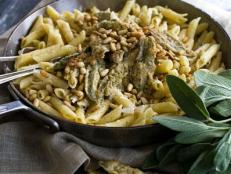Chorizo — Off the Beaten Aisle

Chorizo is a bit like pornography. You’ll know it when you see it, but it’s a bit hard to define in the abstract.
That’s because there are several hundred varieties of this sausage made across at least three continents and many bear little resemblance to the others.
Making matters worse, chorizo makers in the U.S. are a pretty freewheeling bunch. No matter what the packages say, you never quite know what you’re getting.
The good news is that you don’t need to sift through all that to understand why this meat is well worth working into your dinner repertoire.
At its most basic level, chorizo is a sausage made from chopped or ground pork and a ton of seasonings, often including garlic.
The flavors are deeply smoky and savory, with varying degrees of heat. Most are assertive and peppery, but not truly spicy.
The three main producers of chorizo are Spain, Portugal and Mexico. Spanish and Portuguese chorizo (the latter known as chourico) are most common in the U.S., but for many of the products sold here that’s a distinction without a difference. In Spain, chorizo has a distinct red color thanks to ample seasoning with paprika. It is available in two main varieties: cooking and cured.
Cooking chorizo is coarse, crumbly, deliciously fatty, and jammed with spices (which vary by region). The meat can be smoked or plain.
To use cooking chorizo, the casing must be removed. The meat then is crumbled and added to other meats or soups, or sautéed.
Cured chorizo is similarly seasoned — including the paprika — but is cured for at least two months. During this period, bacteria and salt work their flavor magic on the meat. The result is a salami-like sausage with a big, bold, peppery flavor.
Cured chorizo traditionally is thinly sliced and eaten at room temperature. It also can be finely chopped and cooked. Most chorizo sold here is the cured style.
Portuguese chourico adds wine to the flavoring mix, and often is smoked. Most varieties can be thinly sliced and eaten as-is, though it also can be cooked.
Mexican chorizo is made from fresh (not smoked) pork, and generally sports the seasonings we associate with Mexican cuisine, including chiles and cilantro.
While there are some cured varieties of Mexican chorizo, most should be cut open (discarding the casing), crumbled and cooked. Use the meat in just about any Mexican dish calling for meat (and big, big flavor), including nachos.
• Make soup. Thinly slice the chorizo, then combine with sliced onion, garlic, canned chickpeas and chicken broth. Simmer, then ladle into a bowl and spoon pesto over each serving.
• Coarsely chop chorizo, then finely chop in a food processor. Mix into ground beef or turkey, then use for meatballs or meatloaf.
• Thinly sliced chorizo can be used similar to pepperoni on a pizza.
• Add finely chopped chorizo to home fries and hash browns. While you’re at it, sauté a bit, then add to scrambled eggs.
• Finely chop chorizo, then sauté it and a finely diced onion. Add Arborio rice and chicken broth to make a crazy-good risotto.
Sometimes it’s best to not over-think things. As in this basic roasted chicken, my take on a simple French classic. I love that everything is just tossed into a pot, put in the oven and ignored until done.
The recipe calls for a cast-iron Dutch oven. These really are indispensable for making all manner of roasts and stews. And they are as happy on the burner as in the oven (where, when covered, their heavy lids seal in moisture).
Heat the oven to 350 degrees F.
Combine the salt and garlic powder, then rub the mixture over and under the skin of the chicken. Set aside.
In a 5½-quart (or larger) Dutch oven over medium-high, heat the oil. Add the chicken and sear for 5 minutes per side. Transfer the chicken to a plate.
Add the chorizo to the pan, then sauté for 4 minutes. Add the thyme and rosemary. Heat for 30 seconds.
Return the chicken to the pan, breast up. Arrange the onion, carrots, potatoes, lemon and garlic around the chicken, then place the lid over the pot.
Transfer to the oven and roast for 45 minutes, or until the breast reads 160 degrees F on an instant thermometer.
Transfer the chicken to a platter and tent with foil.
Use a slotted spoon to transfer the vegetables and chorizo to a serving bowl. Cover to keep warm. Discard the lemon quarters and any herb stems.
Place the pot over medium heat and bring to a boil. Cook until reduced and thickened, about 3 to 4 minutes. Adjust seasoning with salt and pepper. Serve the sauce drizzled over the chicken.
J.M. Hirsch is the national food editor for The Associated Press. He is the author of the recent cookbook High Flavor, Low Labor: Reinventing Weeknight Cooking . He also blogs at LunchBoxBlues.com.






























































